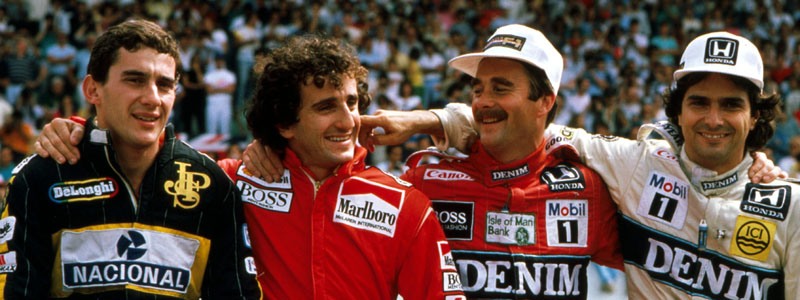On the wall of my cousin’s bedroom is affixed a simple square of black paper, culled from a magazine more than a decade ago. On it, in small, italicised white type, is a quotation:
“God is my co-driver.” — Ayrton Senna (1960-1994)
Though I’ve never been a sports fan — neither player nor spectator — this piece of paper with its simple proclamation has always stayed in my head. It’s elegant, bold, and witty, as all great quotations should be, and laced with the bitter finality of the “-1994” giving it an added poignancy. I knew vaguely that Senna had died, and I knew, vaguely, that he was an amazing driver, but beyond that I had little information — or the inclination to find out more.
With Asif Kapadia’s Senna, I think I can say that the lack of inclination has been blown away.
This documentary, produced and written by Manish Pandey, charts the rise and rise of what many consider the greatest driver in the history of Formula 1 motor racing, from his humble beginnings in go-kart racing to his eventual reign as three-time world champion, along with all the setbacks, rivalries and political drama that he encountered along the way. Even a cursory summary of the Brazilian’s career reads like a novel, and the filmmakers do not shy away from this, crafting anything but a dry artifact.
There are many ways to appreciate Senna the film, from it portrait of the man and his times to its technical construction. Looking at the nuts & bolts of it, the film eschews most documentary tropes of talking head interviews, still photos or recreations, constructing itself entirely out of period footage. Given the sheer amount of coverage an F1 event has, the filmmakers have a wealth of angles and sources to pick from — multiple camera angles cover the same scene, even if it’s just Senna walking around the paddock — and they’ve even managed to include several candid home videos and grainy shots of Senna’s karting years.
Senna often feels less like a documentary and more like an action-packed dramatic movie. It’s nice to see footage from an age before digital HD and 1000fps slow motion replays. Someone out there would be wise to study it and attempt a fiction film using its techniques, its characterful film-grain & video-tape look (I hear Paul Greengrass is planning a Le Mans movie, which would be perfect).
A lot of the cinematic quality of the film is down to a fantastic score by Antonio Pinto. It hits all the right notes with precision, by turns intriguing, tense, breezy and exhilarating. Frequently, the film is scored by distinctly Brazilian music, giving the driving sequences an energy beyond simply the visual.
The task of narration is taken up by a variety of voiceovers from interviews with sports journalists and F1 commentators, many of whom knew Senna personally and can speak of his character as much as his driving. It is a portrait of the man, and not just the career, and this is a good thing.
The downside is that sometimes this borders on hagiography; we’re told in no uncertain terms that Senna weaved magic with the steering wheels and pedals (and this is plain to see from the footage even if you’ve never driven a car in your life, as I have), but while we are shown many of his wins and podium places, rarely do we get to glimpse any other, less successful times. By the end, though, you will be fighting back tears, as this is a movie almost guaranteed to make grown men cry, and with good reason. Senna effectively conveys, in shorthand, why Ayrton Senna was such a figure of hope & joy to millions of Brazilians and others, but sometimes the energetic commentary gets a little too effusive, and makes you wonder: is that all there was?
Not that the film is without Senna’s adversaries, though. His chief on-track adversary is Alain Prost, a driver of surgical precision. They go from cagey teammates to bitter rivals, resulting in several altercations and even crashes. Prost comes off as sly and manipulative of the politics of F1, opposed diametrically to the ruthless ‘pure driving’ philosophy of Senna, but nonetheless a gifted driver, with his own take on how racing should be. F1 chief
Jean-Marie Balestre, however, is the real mustache-twirling villain of the piece, and the seeming puppet-master behind many incidents where Senna is thwarted. How accurate these pictures are is unknown to me, but it makes for some very entertaining — and often laugh-out loud — sequences as Senna, Prost & Balestre duel to have their way.

One of my prevailing memories of Ayrton Senna before this film is one where he, spotting a car on the track ahead that has suffered a crash, abruptly pulls over and runs full-tilt towards the smoking wreckage to help the driver, even before safety crews arrive. To me it illustrates perfectly the character of the man who said “God is my co-driver”, who dreamed — and often achieved — the perfection of ‘pure driving’ without sacrificing his humanity. And unfortunately, in Senna this footage is buried in the credits scroll, shoved to one side.
I think what Kapadia & Pandey have achieved with their film is great, from a technical standpoint and as a piece of entertainment — it’s a treat to watch, though you know you aren’t quite getting the whole picture. It is an honour to know that a man like Senna lived, and a shame to know that he died well before his time. In the end, though, I left with an appreciation of Senna the man more than Senna the film.
And that, I suppose, is how it should be.




